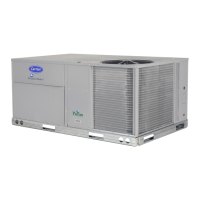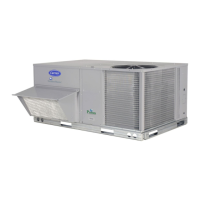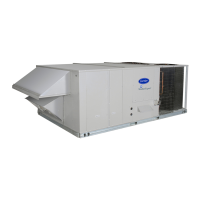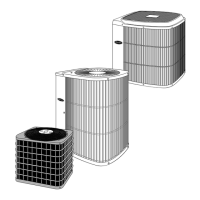IMPORTANT: Never open system under vacuum to atmosphere
without first breaking it open with nitrogen.
Deep Vacuum Method
The deep vacuum method requires a vacuum pump capable of
pulling a vacuum of 500 microns and a vacuum gage capable of
accurately measuring this vacuum depth. The deep vacuum
method is the most positive way of assuring a system is free of air
and liquid water. (See Fig. 10.)
Triple Evacuation Method
The triple evacuation method should only be used when vacuum
pump is only capable of pumping down to 28 in. of mercury and
system does not contain any liquid water. Refer to Fig. 11 and
proceed as follows:
1. Pump system down to 28 in. of mercury and allow pump to
continue operating for an additional 15 minutes.
2. Close service valves and shut off vacuum pump.
3. Connect a nitrogen cylinder and regulator to system and open
until system pressure is 2 psig.
4. Close service valve and allow system to stand for 1 hr During
this time, dry nitrogen will be able to diffuse throughout the
system, absorbing moisture.
5. Repeat this procedure as indicated in Fig. 11. System will then
contain minimal amounts of contaminants and water vapor.
FINAL TUBING CHECK
IMPORTANT: Check to be certain factory tubing on both indoor
and outdoor unit has not shifted during shipment. Ensure tubes are
not rubbing against each other or any sheet metal. Pay close
attention to feeder tubes, making sure wire ties on feeder tubes are
secure and tight.
Table 2—Accessory Usage
ACCESSORY
REQUIRED FOR LOW-AMBIENT
APPLICATIONS
(BELOW 55°F)
REQUIRED FOR LONG-LINE
APPLICATIONS
*
(OVER 50 FT)
Wind Baffle See Low-Ambient Instructions No
Support Feet Recommended No
Puron® Balanced-Port Hard Shutoff TXV Yes† Yes†
Puron® Liquid-Line Solenoid Valve for Heating No
See Long-line
ApplicationGuideline
* For tubing line sets between 50 and 175 ft, for 20 ft vertical differential refer to Application Guideline and Service Manual for Residential Split-System Air Conditioners
and Heat Pumps using Puron® Refrigerant.
†Required for all applications. Factory supplied with outdoor unit.
Fig. 9—Filter Drier with Sweat Adapter Tube and
Liquid Tube
A97555
R
-
4
1
0
A
LIQUID
SERVICE
VALVE
LIQUID-LINE
FILTER-DRIER
Fig. 10—Deep Vacuum Graph
A95424
500
MINUTES
01234567
1000
1500
LEAK IN
SYSTEM
VACUUM TIGHT
TOO WET
TIGHT
DRY SYSTEM
2000
MICRONS
2500
3000
3500
4000
4500
5000
A95424
Fig. 11—Triple Evacuation Method
A95425
CHECK FOR TIGHT, DRY SYSTEM
(IF IT HOLDS DEEP VACUUM)
EVACUATE
BREAK VACUUM WITH DRY NITROGEN
WAIT
EVACUATE
CHARGE SYSTEM
BREAK VACUUM WITH DRY NITROGEN
EVACUATE
WAIT
6

